
Rapa Nui, also known as Easter Island, is a small island located in the southeast Pacific Ocean. It is most famous for nearly 1,000 large statues called moai, which have human faces. The island measures about 14 miles long and 7 miles wide. This makes it possible to walk across in just one day.
It is the most remote inhabited place on Earth. Its nearest neighbors include the Pitcairn Islands, about 1,200 miles to the west, and Chile, the nearest country on the South American mainland, about 2,300 miles to the east.
The rich history of Rapa Nui
Humans first settled on Rapa Nui around A.D. 1000, during a period of Polynesian exploration. A chief named Hotu Matu’a, having heard about the island from explorers, led a small group of no more than 100 people from either the Marquesas Islands or Rarotonga to settle here.
When these settlers arrived, they encountered an island lush with palm trees and other vegetation. However, over the centuries, the landscape dramatically transformed, becoming barren by the 19th century. The introduction of the Polynesian rat, which had no natural predators on the island and multiplied rapidly, likely influenced this transformation.
Deciphering the Moai
The creation of the moai statues is one of the island’s most intriguing mysteries. Researchers believe these statues were transported and erected using paths or “roads” from quarries to their locations along the island’s coast.
Despite being near the ocean, all the moai face inland. This suggests that they were meant to honor figures or deities from within the island itself. The reason why their construction stopped suddenly around the 1720s remains a topic of debate.
Scientific research and insights
Carl Lipo, a professor of anthropology at Binghamton, State University of New York, and Terry Hunt, professor of anthropology University of Hawaii, and their team led a groundbreaking study in 2024.
They used shortwave infrared satellite imagery and machine learning to detect and analyze the ancient rock gardens, or “manavai,” across the island. These gardens were vital for sustaining agriculture in an environment challenged by deforestation.
The inhabitants of Rapa Nui had designed these rock gardens ingeniously. By arranging rocks in specific patterns, they created microenvironments that trapped moisture and enhanced soil fertility. This practice, known as lithic mulching, involved using rock minerals to enrich the soil, thereby supporting crop growth despite harsh conditions.
The findings from this study indicate that these gardens were extensive and sophisticated enough to support a stable population. The researchers concluded that Rapa Nui’s population remained steady at about 3,900 people before European contact, challenging previous theories of dramatic population fluctuations due to ecological collapse.
Cultural legacy and modern day
Rapa Nui is also home to a unique written script known as Rongorongo, which remains undeciphered. Researchers believe this script may have developed independently, a rare feat in human history. Today, Rapa Nui draws thousands of visitors each year.
Restorers have returned many moai to their platforms, and the island’s economy now heavily relies on tourism. With a current population of over 5,000 people, the community actively supports a thriving tourism industry, showcasing its rich history and cultural heritage to the world.



